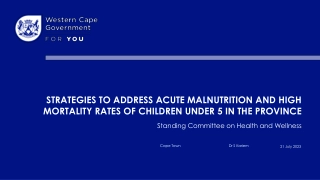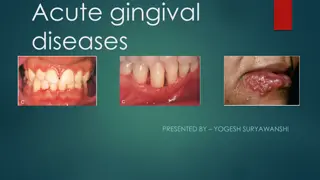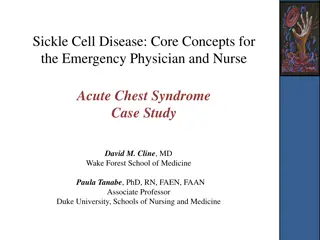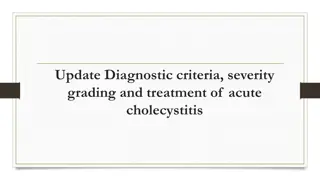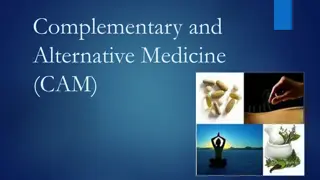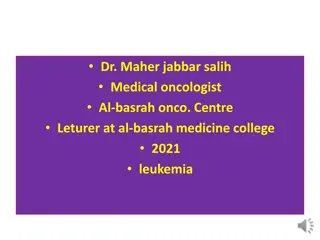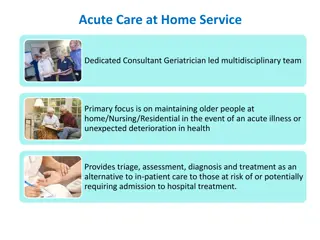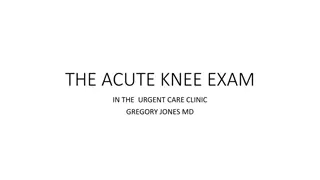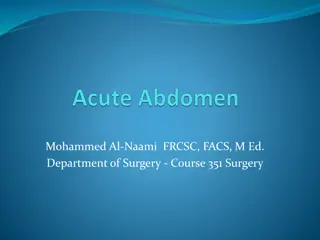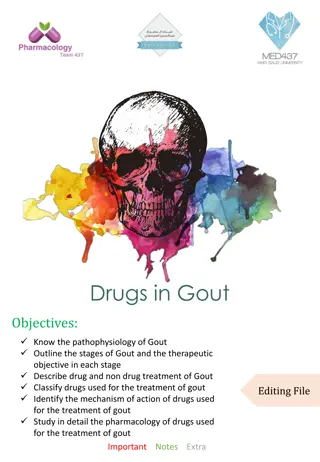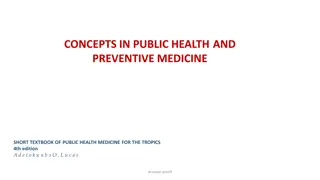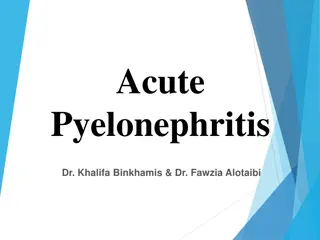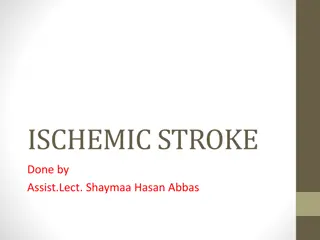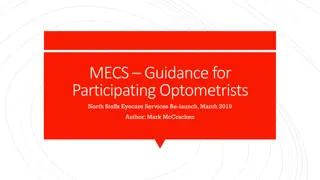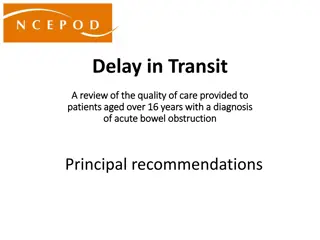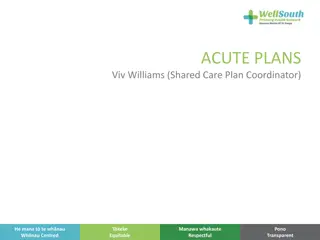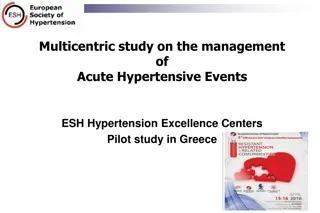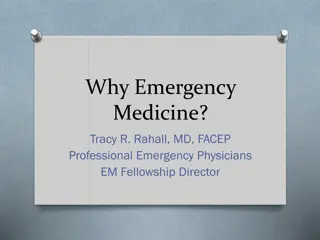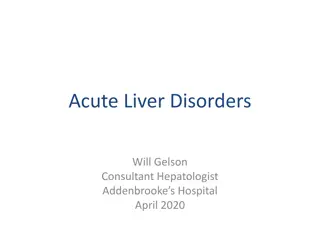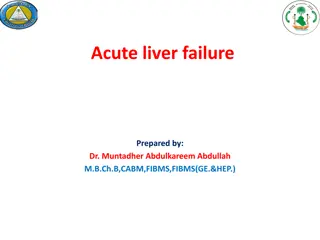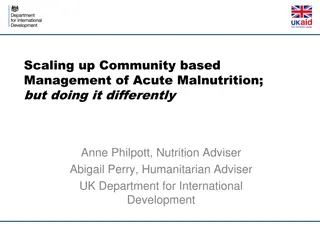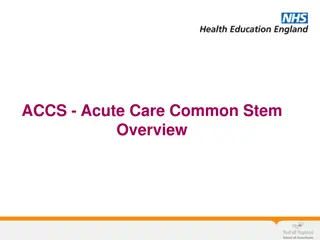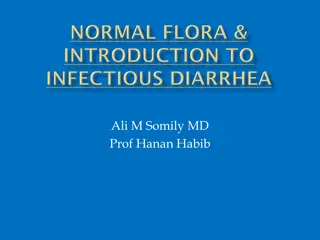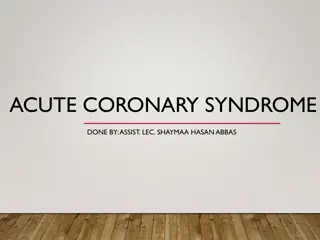Strategies to Address Acute Malnutrition and High Mortality Rates in Children Under 5
Malnutrition in children under 5, specifically acute malnutrition, is a pressing issue in the Western Cape. This presentation outlines the current strategies, multisector engagement, causes, and impacts of acute malnutrition. It delves into the classifications of malnutrition, including severe and m
1 views • 38 slides
Acute orofacial pain
Acute orofacial pain is often associated with dental issues, ranging from dentinal pain to periodontal pain. The pain can be moderate to severe, with various triggers such as mechanical stimulation and changes in osmotic pressure. This pain is prevalent in adults and can spread to different areas of
1 views • 49 slides
Overview of Acute Gingival Diseases
Acute gingival diseases encompass various conditions such as Necrotizing Ulcerative Gingivitis, Necrotizing Ulcerative Periodontitis, Necrotizing Ulcerative Stomatitis, and others. Necrotizing Ulcerative Gingivitis (NUG) is a microbial disease primarily affecting the gingiva, characterized by necros
5 views • 67 slides
Managing Acute Chest Syndrome in Sickle Cell Disease
A case study of a 31-year-old male with sickle cell disease presenting in the emergency department with a pain crisis. The patient has a history of avascular necrosis, priapism, NSTEMI, cholecystectomy, and previous acute chest syndrome. Explore the patient's symptoms, past medical history, and reco
7 views • 19 slides
Understanding Lifestyle Medicine: A Holistic Approach to Health
Lifestyle medicine is a medical specialty focused on using evidence-based lifestyle interventions to treat chronic conditions like cardiovascular diseases, type 2 diabetes, and obesity. Clinicians trained in lifestyle medicine emphasize whole-person care through nutrition, physical activity, stress
10 views • 10 slides
MD MS IN UK WITHOUT PLAB,PG MD MS IN UK
MD MS IN UK WI Internal Medicine without PLAB is a Three Years Full Time Hands on Training Program. The course constitutes hands-on training in all major clinical specialties e.g. Cardiology, Acute Medicine, Gastroenterology, Diabetes, Psychiatric Medicine, Stroke Medicine and Neurology and others,
7 views • 4 slides
Overview of Acute Cholecystitis: Diagnosis, Severity Grading, and Treatment
Acute calculous cholecystitis is a common digestive disease with varying treatment perspectives. The Tokyo Guidelines 2018 provide criteria and severity grading for the diagnosis of acute cholecystitis. Diagnosis involves local and systemic signs of inflammation along with specific imaging findings.
0 views • 18 slides
Understanding Complementary and Alternative Medicine (CAM)
Complementary and Alternative Medicine (CAM) encompasses various treatments, ranging from herbs to yoga, that differ from traditional Western medicine. While complementary medicine involves using these therapies alongside conventional medicine, alternative medicine opts for non-mainstream approaches
2 views • 20 slides
Understanding Leukemia: Causes, Types, and Treatment Options
Leukemia is a group of blood disorders characterized by abnormal white blood cell production. Factors like genetics, environment, and mutations in DNA play a role in its development. Acute leukemia requires urgent treatment due to rapid cell growth, while chronic leukemia progresses more slowly. The
1 views • 20 slides
Comprehensive Acute Care at Home Service for Older Adults
This service, led by a dedicated consultant geriatrician and multidisciplinary team, focuses on providing acute care at home for older individuals at risk of hospital admission. The inclusion criteria, referral process, and interventions offered are outlined, emphasizing the aim of maintaining patie
0 views • 5 slides
Global Nutrition Prevalence Rates in Children and Women
This content highlights the prevalence rates of acute malnutrition, severe acute malnutrition (SAM), moderate acute malnutrition (MAM), childhood stunting, acute malnutrition based on MUAC and edema, and acute malnutrition in pregnant and lactating women. The data is based on various criteria such a
9 views • 37 slides
Comprehensive Guide to Acute Knee Examination in Urgent Care
This detailed guide covers the essential components of the acute knee exam conducted in an urgent care setting by Dr. Gregory Jones, including chief complaints, anatomy, examination techniques, ligament assessments, practical aspects, and more. The examination process involves assessing functional l
1 views • 27 slides
Understanding Inflammation and Its Characteristics
Inflammation is the response of tissues to harmful agents, categorized as acute or chronic. Acute inflammation is rapid and short-lived, while chronic inflammation is insidious and prolonged. Chemical mediators play a crucial role in both forms, leading to tissue necrosis. The five cardinal signs of
3 views • 27 slides
Comprehensive Overview of Acute Abdomen Assessment and Management
This detailed guide covers the definition, general approach, history taking, physical examination, investigations, diagnosis, and management of acute abdomen cases. Learn about common causes, such as acute appendicitis, bowel obstruction, and medical conditions. Real-life scenarios illustrate differ
2 views • 15 slides
Understanding Gout: Pathophysiology, Stages, and Treatment Options
Gout is characterized by acute inflammatory arthritis due to sodium urate crystal deposits. Untreated gout can lead to complications like tophi, nephrolithiasis, and joint inflammation. The disease progresses through stages: acute, asymptomatic hyperuricemia, intercritical, and chronic gout. Treatme
0 views • 13 slides
Understanding Concepts in Public Health and Preventive Medicine
The evolution of nomenclature in public health, from hygiene to preventive medicine and social medicine, reflects the collective efforts to prevent disease, prolong life, and promote health. Key elements of modern public health include collective responsibility, state intervention, prevention emphas
0 views • 16 slides
Understanding Acute Pyelonephritis: Risk Factors, Etiology, and Management
Acute pyelonephritis is a bacterial infection of the kidney associated with serious complications. This article discusses the definition, risk factors, etiology, and pathogenesis of the condition. It also covers the clinical presentation, diagnosis, management, and prevention strategies for acute py
0 views • 18 slides
Rehabilitation Considerations During the COVID-19 Outbreak
Rehabilitation services during the COVID-19 pandemic are crucial for continuing essential care and optimizing outcomes, especially for individuals with severe COVID-19 cases. Considerations for non-COVID-19 rehabilitation services must be maintained to address acute injuries, post-surgical recovery,
0 views • 14 slides
Cognitive Stimulation Therapy in Post-Acute Care: A Pilot Study
Cognitive Stimulation Therapy (CST) is an evidence-based group intervention designed for individuals with mild to moderate cognitive impairment. It aims to enhance cognitive functioning through various activities such as executive functioning tasks, multi-sensory stimulation, and reminiscence work.
0 views • 9 slides
Inpatient Management of Severe Acute Malnutrition Training Course 2011
This training course focuses on inpatient management of severe acute malnutrition, teaching procedures outlined in the national Community-Based Management of Severe Acute Malnutrition Guidelines. The training aims to reduce case fatality rates significantly and is designed for physicians, senior nur
0 views • 9 slides
Acute Malnutrition - Fluid Management and Treatment Overview
Acute malnutrition, particularly severe acute malnutrition (SAM), requires careful fluid management and a structured treatment approach involving stabilization, transition, and rehabilitation phases. This condition results from inadequate dietary intake or acute infections, leading to severe wasting
0 views • 23 slides
Comprehensive Treatment Guidelines for Acute Ischemic Stroke
In the management of acute ischemic stroke, the primary goals are to reduce secondary brain damage, maintain adequate perfusion, and prevent recurrent strokes by managing risk factors. Treatment includes maintaining tissue oxygenation, correcting volume status and electrolytes, managing blood glucos
0 views • 20 slides
Understanding Abnormal Liver Function Tests: Acute vs. Chronic Approach
Comprehensive discussion on assessing patients with abnormal liver test results, focusing on distinguishing between acute and chronic liver conditions. Covers diagnostic workup, patient cases, and differential diagnosis, emphasizing the importance of patient history, physical examination, and key di
0 views • 16 slides
Enhanced Eyecare Services for Optometrists in North Staffordshire
North Staffordshire Minor Eye Conditions Service (MECS) has been re-launched to provide a comprehensive managed service for treating common eye problems by local community optometrists. MECS offers a broader scope than the previous Acute Eye pathway, enabling the management of both acute and non-acu
0 views • 19 slides
Review of Care for Patients with Acute Bowel Obstruction: Recommendations and Key Findings
This review assesses the quality of care provided to patients aged over 16 years with acute bowel obstruction. Significant delays were identified in the care pathway, from imaging requests to availability of operating theatres. Recommendations include prompt CT scans with intravenous contrast for de
0 views • 32 slides
Comprehensive Guide to Creating and Understanding Acute Care Plans
This comprehensive guide provides detailed information on creating and understanding acute care plans, including the purpose of an acute plan, who needs one, what information can be written in an acute plan, examples of baseline clinical parameters, alerts to more detailed plans, and insights into c
0 views • 17 slides
Epidemiology of Hepatitis B and C in Florida: 2019 Data Analysis
The Department of Health in Florida has released the 2019 data on the epidemiology of Hepatitis B and C as of January 21, 2021. The report includes information on acute and chronic cases, technical notes on case definitions, and changes in national case definitions in 2020. Acute cases require speci
0 views • 35 slides
Understanding Pain Management: Acute vs. Chronic Pain and Interventional Therapies
Pain is a complex experience that can be acute or chronic, requiring different treatment approaches. Acute pain alerts us to potential injury, while chronic pain lasts longer and affects quality of life. Management options range from medical and psychological treatments to advanced interventions and
0 views • 26 slides
Multicentric Study on the Management of Acute Hypertensive Events in Greece
This study focuses on acute hypertensive events, including hypertensive crises and emergencies, aiming to assess prevalence, characteristics of patients, and management strategies in Greek hospitals. The study involves a national, multicentric, non-invasive approach in collaboration with Hellenic ES
0 views • 7 slides
The Role of Family Physicians in Emergency Medicine: A Historical Perspective
Family physicians have played a crucial role in the development of emergency medicine as a specialty, with many physicians transitioning and contributing to the field. Despite some controversy surrounding their role, organizations like AAFP have supported family physicians practicing emergency medic
0 views • 22 slides
Understanding Acute Liver Disorders: Causes, Presentations, and Management
Acute liver disorders can have various causes such as drugs, viruses, ischemia, autoimmune conditions, and more. The presentations of acute liver disease can include abnormal liver tests, jaundice, liver impairment, and even liver failure. Management involves removing and treating the underlying cau
0 views • 16 slides
Overview of Acute Liver Failure: Causes, Classification, and Diagnosis
Acute liver failure is a severe condition characterized by rapid liver dysfunction within 6 months of symptom onset, leading to encephalopathy, coagulopathy, and jaundice. This condition can be classified as hyperacute, acute, subacute, fulminant, or sub-fulminant based on the duration from jaundice
0 views • 16 slides
Understanding Acute Visual Loss: Causes and Evaluation
Loss of vision can occur suddenly, affecting one or both eyes and various parts of the visual field. This guide explores the definition, pathophysiology, and evaluation of acute visual loss. Common causes include optic nerve diseases, retinal disorders, and vascular issues. The visual pathway from t
0 views • 37 slides
Approach to Acute Flaccid Paralysis in Children: Evaluation and Management
Acute muscular weakness in children is a neurological emergency defined by sudden onset muscle weakness or paralysis in less than 5 days. When evaluating a child with acute flaccid paralysis, consider factors like onset rhythm, associated symptoms, and past medical history. A thorough physical and n
0 views • 45 slides
Integration of Complementary Medicine in Cancer Care in Tuscany
Describes the successful integration of Complementary Medicine in the network of Cancer Departments within the Tuscan Public Healthcare System. The initiative, spearheaded by experts in both Complementary Medicine and medical oncology, has led to the development of Regional Guidelines incorporating
0 views • 4 slides
Children's Hospital @ Home: Acute Nursing Care in Tower Hamlets
Providing acute nursing care for children at home from 8 am to 10 pm, the Children's Hospital @ Home in Tower Hamlets offers services such as IVABs, NGT re-insertion, acute assessment, wheeze management, and home-based phototherapy. The initiative aims to reduce hospital stays, minimize admissions f
0 views • 7 slides
Innovative Approaches in Scaling Up Community-Based Management of Acute Malnutrition
Scaling up community-based management of acute malnutrition is vital for reaching vulnerable populations. DFID's efforts in countries like Malawi, India, and Ethiopia showcase unique strategies such as local production of RUTF, piloting CMAM in communities, and integrating CMAM into national nutriti
0 views • 7 slides
Overview of ACCS Training in East of England
ACCS (Acute Care Common Stem) Training in the East of England region is overseen by the ACCS Specialty Training Committee, involving Emergency Medicine, Acute Medicine, Anaesthetics, and Intensive Care Medicine. Trainees complete rotations in different specialties and are provided supervision and su
0 views • 10 slides
Understanding Acute Diarrheal Illness and Gastrointestinal Infections
Acute diarrheal illness is a common issue globally, leading to significant morbidity and mortality. This lecture covers the types of acute diarrhea, host defenses, pathogens like E. coli, Campylobacter, and Yersinia, and their management. It also discusses microbiological diagnosis methods, food poi
0 views • 30 slides
Understanding Acute Coronary Syndrome: Diagnosis and Immediate Therapies
A 58-year-old man presents with acute severe chest pain, diaphoresis, dyspnea, and risk factors for coronary heart disease. The most likely diagnosis is acute myocardial infarction. Immediate steps include placing the patient on a cardiac monitor, obtaining an ECG, and administering aspirin. Additio
0 views • 19 slides
